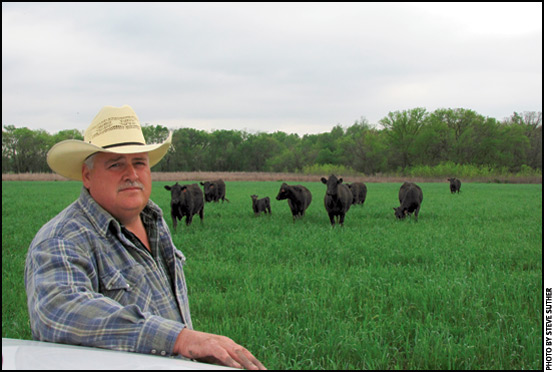Test for the Best, Cull the Rest
Kansas commercial Angus herd first to use GeneMax.®
Kevin Wellnitz and daughter Jennifer are of one mind when it comes to a vision for their 200-cow Plum Creek Ranch Angus herd, near Neosho Rapids, Kan. As herd managers, they want to keep only the best, and make selection calls as soon as possible.
That helps explain why they were the first to use the GeneMax® DNA test when it was made available by Certified Angus Beef LLC (CAB) in February for blood or at least 20 hair root follicles per animal.
Jennifer said, "On the first 23 head, we just tried to represent some from each sire group."
"We wanted to see if there was any correlation between the sire groups and the results," Kevin continued. Read more.

Jerry Cassady
Association Perspective
Take care of your new herd bull.
Have you ever noticed that when we buy something new, a new car for example, we give it extra care and added attention? We make more trips to the car wash, wiping, waxing, trying to keep it "new" for as long as possible. Shouldn't you follow the same protocol for your newly purchased herd bull? Now, don't think I'm referring to washing and polishing your new herd sire; however, a little extra care and attention to detail with this new addition may be well worth your time. Read more.
Looks Can Tell in Beef Cattle
Why some apples fall farther from the tree.
"Boy, if he isn't a spitting image of his grandpa!"

Bob Weaber
You've likely heard similar references before, and they make this concept easy to grasp: Just like people, cattle don't inherit genes equally.
"Because of random assortment and recombination, or crossover events during the sperm or egg cell formation, they can get an unequal proportion of genetic material from their grandparents," says Bob Weaber, Kansas State University animal scientist.
Thus, an animal might favor its maternal grandfather and look nothing like the paternal one — which matters in cattle herds where sires vary greatly for economically important traits. Read more.
Legislation Introduced to Mitigate
Catastrophic Wildfire Risk
Bill would allow forest fire fuel loads to be responsibly managed.
Congressman Paul Gosar (R-Ariz.) was joined by 27 of his colleagues in the U.S. House of Representatives to introduce the bipartisan Catastrophic Wildfire Prevention Act of 2012 (H.R. 5744). According to Public Lands Council President John Falen, H.R. 5744 will allow forestlands to be responsibly managed to prevent catastrophic wildfires that put human and animal health and safety at risk while costing economies severely.
"Decades of mismanagement and convoluted environmental regulation have left our nation's vast forestlands one spark away from a catastrophic wildfire," Falen said. "In many parts of the nation, these forests, which have historically provided grazing land for livestock and habitat to wildlife, are nothing more than kindling for the next big fire." Read more.
New Way to Think of Land Prices
Think of land price as bushels of corn, MU economist tells Breimyer Seminar participants.
To help farmers decide how much debt farmland can support, Joe Horner asks them to calculate payments not in dollars but in bushels of corn. That may surprise some on how cheap land has become. Horner led those at the 2012 Breimyer Seminar through his way of thinking about how much mortgage payment a farm can absorb.
The University of Missouri (MU) seminar on land prices reminded Horner of his days in a county extension office.
"Impossible-to-answer questions came in the front door," he recalls. "What's a farm worth?" Read more.
What’s Inside …
In this May edition of the Angus Beef Bulletin EXTRA, you'll find valuable articles devoted to the management, marketing, and health and nutrition of your beef enterprise. Select from the tabs at the top of the page to access this month's entire offering by category. A few select features include:
- Cow Camp Chatter: Add value to bred heifers.
- Magnetic Solution
- National Cattle Evaluation for Feed Intake & Efficiency
- BRD Control Starts With Mama's Health Management
- Snakebite
- In the Cattle Markets: Cow prices remain at record levels.
- Dinner Plate-to-Farm Gate Education
News Briefs …
The American Angus Association and its subsidiaries generate a wealth of information to keep members and affiliates informed of what's happening within the industry as well as with the programs and services they offer. Click here for easy access to the newsrooms of the American Angus Association and Certified Angus Beef LLC and the Angus e-List archive.
Dicey Odds for Continued Drought
Producers may need more than luck to manage.
A "coin toss" is how a Texas drought expert describes the forecast for rainfall across the state this season. But there are some actions farmers and ranchers can take rather than hoping for a stroke of luck.
"There's a high probability that we're going to have abnormally warm temperatures over the next six months," said Travis Miller, Texas AgriLife Extension Service agronomist and drought spokesperson. "And there's an equal chance of above- or below-normal precipitation. This drought is not over for large areas of the state."
The National Integrated Drought Information System predicts that the drought will persist or intensify for more than half of Texas through July. Read more.
Is Healthy Food Less Affordable?
USDA compares cost of recommended foods, less healthy options.
"The diet of most Americans falls short of federal recommendations, especially when it comes to whole grains, low-fat dairy products, and fruits and vegetables," says Andrea Carlson of the Food Markets Branch of USDA's Economic Research Service in a recent blog. "Some nutrition researchers and food writers blame cost, saying fruits and vegetables and other healthy foods are more expensive than less healthy ones. And, on a per calorie basis, that's true. Calorie-sparse fruits and vegetables cost more than a donut, and skim milk costs more than whole. But is price per calorie the only way to think about a food's cost?" Read more.
[Click here to go to the top of the page.]













